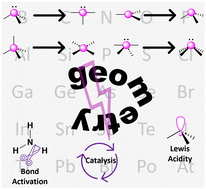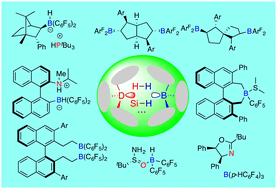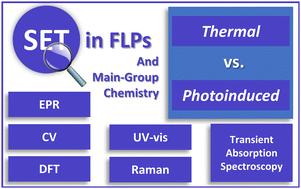Themed collection Applications of Main Group Chemistry in Synthesis, Catalysis, and Biomedical and Materials Research

Recent advances in the chemistry of isolable carbene analogues with group 13–15 elements
This review provides an overview of main group carbene analogues, covering recent advancements, synthesis strategies, and the diverse reactivity of elements in groups 13–15 based on their structural characteristics.

Chem. Soc. Rev., 2024,53, 3896-3951
https://doi.org/10.1039/D3CS00784G
Low oxidation state and hydrido group 2 complexes: synthesis and applications in the activation of gaseous substrates
This review summarises advances in the chemistry of low-oxidation state and hydrido group 2 metal complexes, focussing on their use for the reductive activation of feed-stock gaseous small molecules, and their subsequent transformation into value added products.

Chem. Soc. Rev., 2024, Advance Article
https://doi.org/10.1039/D4CS00097H
Borataalkenes, boraalkenes, and the η2-B,C coordination mode in coordination chemistry and catalysis
This review summarizes the recent advances in the synthesis of transition metal borataalkene and boraalkene complexes, and the η2-B,C coordination mode in homogeneous catalysis.

Chem. Soc. Rev., 2024,53, 1915-1935
https://doi.org/10.1039/D3CS00730H
Organoboron-based multiple-resonance emitters: synthesis, structure–property correlations, and prospects
This review highlights organoboron-based multiple-resonance compounds’ synthetic strategies classified as one-pot borylation, one-shot borylation, and late-stage functionalisation, and explores material structure–photophysical property correlations.

Chem. Soc. Rev., 2024,53, 1624-1692
https://doi.org/10.1039/D3CS00837A
Ligand-enforced geometric constraints and associated reactivity in p-block compounds
This review presents a group-wise summary of ligand enforced non-VSEPR geometries in compounds of the p-block elements and discusses the emergent consequences for reactivity.

Chem. Soc. Rev., 2024,53, 764-792
https://doi.org/10.1039/D3CS00765K
Boryl-substituted low-valent heavy group 14 compounds
This review focuses on the low-valent heavy group 14 compounds stabilized by N-heterocyclic boryl ligands and their applications in the activation of small molecules and inert chemical bonds.

Chem. Soc. Rev., 2024,53, 361-379
https://doi.org/10.1039/D3CS00791J
Azaphosphinines and their derivatives
Azaphosphinines, six-membered heterocycles containing one phosphorus and one nitrogen atom, have emerged from the shadows of their single heteroatom-containing analogues. This review describes the synthesis and applications of these unique compounds.

Chem. Soc. Rev., 2023,52, 8599-8634
https://doi.org/10.1039/D3CS00737E
Asymmetric catalysis with FLPs
This review provides an overview of the important progress in FLP-catalyzed asymmetric reactions made over the past 15 years, and both the merits and limitations of FLP-catalysis have been highlighted.

Chem. Soc. Rev., 2023,52, 8580-8598
https://doi.org/10.1039/D3CS00701D
Frustrated Lewis pair chemistry of CO
This review discusses the application of FLPs to the capture, reactivity, and reduction of CO. These developments illustrate an alternative strategy to advance the reactivity of CO.

Chem. Soc. Rev., 2023,52, 4632-4643
https://doi.org/10.1039/D3CS00294B
Mechanistic studies on single-electron transfer in frustrated Lewis pairs and its application to main-group chemistry
Here, we discuss predicting thermal and photoinduced single-electron transfer (SET) in frustrated Lewis pairs (FLPs) and characterizing the resulting radical pair. We then extend these methods' application to main-group chemistry.

Chem. Soc. Rev., 2024, Advance Article
https://doi.org/10.1039/D4CS00185K
About this collection
The main group elements are among the most abundant elements in the universe. These representative elements comprise 80% of the Earth’s crust and are critical for supporting life with a wide variety of applications. This special collection, Guest Edited by Douglas Stephan (University of Toronto, Canada) and Shih-Yuan Liu (Boston College, United States of America), aims to highlight the versatility of main group chemistry in diverse applications ranging from biomedical research to materials and catalysis science. The collection showcases the unique functional properties and novel reactivities that main-group compounds exhibit. With the contributions of eminent scholars in the field, the collection captures some of the recent advances in main group chemistry and share our excitement with the broader community. We hope you enjoy reading the articles in this collection.